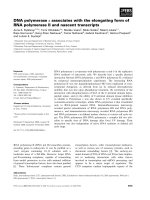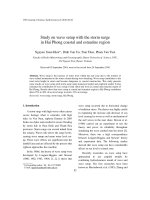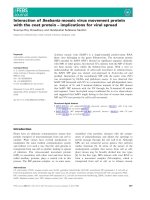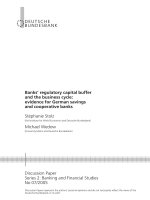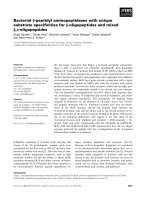Keeping Up with the Corporate University Resources for HRM Faculty and Practitioners
Bạn đang xem bản rút gọn của tài liệu. Xem và tải ngay bản đầy đủ của tài liệu tại đây (744.14 KB, 27 trang )
144 Sherer & Shea
Copyright © 2005, Idea Group Inc. Copying or distributing in print or electronic forms without written
permission of Idea Group Inc. is prohibited.
Chapter VII
Keeping Up with the
Corporate University:
Resources for HRM
Faculty and Practitioners
Pamela D. Sherer, Providence College, USA
Timothy Shea, University of Massachusetts Dartmouth, USA
Abstract
The number of corporate universities is increasing by leaps and bounds,
and the role of corporate universities is rapidly evolving and becoming
more tightly integrated with an organization’s strategic planning and
assessment. How can HRM faculty and practitioners keep their respective
curricula and organizations up to date? The first section of this chapter
provides an overview of the current corporate university landscape,
discussing the three major factors that influence both their growth and
their role in organizations: strategy and human resources, knowledge
management, and technology and e-learning. The second section includes
an annotated compendium of key resources in each of these areas,
especially Internet resources.
Keeping Up with the Corporate University 145
Copyright © 2005, Idea Group Inc. Copying or distributing in print or electronic forms without written
permission of Idea Group Inc. is prohibited.
Introduction
Corporations have been in the business of training and developing employees
for a long time. It was estimated that U.S. companies would spend approxi-
mately $56.8 billion (Galvin, 2002) on education and training in 2002 as a
means both for keeping employee skills, knowledge, and abilities updated, and
to better retain top employees (Van Buren & Erskine, 2002; Dillich, 2000;
Koprowski, 2000). The rapid development of corporate universities, espe-
cially during the last few years, has proven effective in meeting these educational
needs (Vine & Palsule, 1999).
The idea of a corporate university is not new. Meister (1998) describes the
General Motors Institute, founded in 1927, as the first. However, the origins of
modern corporate universities can be traced to the period of the late 1950s
through the 1960s. During that time Disney University, General Electric’s
Crotonville Management Development Institute, McDonald’s Hamburger
University, and several others were established. Jarvis (2001) indicates that
these in-house training programs were developed in large part to supplement
the traditional, off-site education that their staff members were receiving.
Over the past 15 years, the number of corporate universities has increased from
400 to over 2,000; that number is expected to surpass 3,700 by the end of this
decade (Anderson, 2001). Corporate universities are found in virtually all
industries: consulting, high tech, military, entertainment, financial services,
healthcare, automobile, and fast food, to name a few. Examples of domestic
and international companies with corporate universities include American
Skandia, Black and Decker, Booz Allen Hamilton, Daimler-Chrysler, Defense
Acquisition, Dell, Disney, eArmy, General Motors, Harley-Davidson, Infosys
Technologies Limited, Intel, Isvor Fiat, McDonald’s, Land Rover, Motorola,
the North Shore - Long Island Jewish Health System, Oracle, the Tennessee
Valley Authority, Schwab, and Unisys.
Of particular interest is the fact that many corporate universities are now
extensively involved with their organization’s strategic planning processes
(Carter, Giber, & Goldsmith, 2001). As a result, leaders of human resource
management and development departments in these organizations are rapidly
becoming repositioned to the highest levels of organizational influence and
decision making, including the introduction of a new position, the Chief
Learning Officer (CLO) (Baldwin & Danielson, 2000). Utilizing the rapid
advancement of e-learning and e-human resource development technologies,
146 Sherer & Shea
Copyright © 2005, Idea Group Inc. Copying or distributing in print or electronic forms without written
permission of Idea Group Inc. is prohibited.
in conjunction with knowledge management concepts, the corporate university
of today is quickly becoming the primary vehicle for conceptualizing, imple-
menting, and assessing workplace learning opportunities based upon corporate
strategies. However, because we are in the middle of a rapid evolutionary
phase in the shape and purpose of corporate universities, the final shapes are
unclear. A major issue that is currently being worked out is whether organiza-
tional strategic learning objectives are best served by companies that empha-
size blended learning solutions or those that are pursuing Web-based virtual
corporate universities.
A steady stream of articles, conferences, and on-site workshops on corporate
university concepts has emerged over the past few years. Consulting organiza-
tions have developed expertise and can guide corporations through the design
and implementation of a corporate university. Yet, with all the corporate
university developments and accomplishments — in fact, because of the speed
of the evolution of corporate universities — HRM practitioners wishing to
develop a corporate university and HRM faculty wishing to create or update
their courses or conduct research can find it difficult to keep up. For example,
our leading graduate and undergraduate management and human resource
textbooks currently provide minimal exposure to corporate universities and
their impact on workplace learning and their role in organizational change
(Jackson & Schuler, 2003; Mathis & Jackson, 2003; Noe, Hollenbeck,
Gerhart, & Wright, 2003; Wexley & Latham, 2002). This chapter provides a
way to “jump in” to the world of corporate universities and key resources to
help in “keeping up” as the number of corporate universities continues to grow
and the concept itself continues to evolve.
Based on a year-long funded study of corporate universities that included a
number of site visits, a review of the literature, and a review of relevant Web
sites, this chapter provides a primer on corporate universities for HRM
practitioners, researchers, as well as management and human resource faculty
responsible for delivering HRM curriculum to undergraduate and graduate
students.
The first section of this chapter provides an overview of the current corporate
university landscape by discussing the definition of a corporate university, the
different purposes of corporate universities, the three major factors that
influence both their growth and their role in organizations (strategy and human
resources, knowledge management, and technology and e-learning), examples
of corporate universities today, and emerging research models and research
opportunities. The second section of the chapter provides HRM practitioners
Keeping Up with the Corporate University 147
Copyright © 2005, Idea Group Inc. Copying or distributing in print or electronic forms without written
permission of Idea Group Inc. is prohibited.
and faculty with a ready means for periodically updating their understanding of
these rapidly evolving phenomena. This section includes an annotated compen-
dium of key resources (books, articles, reports, and Web sites) organized by
the four subject areas — corporate universities, strategy and human resources,
knowledge management, and technology and e-learning.
The Web sites, in particular, offer up-to-date perspectives on corporate
universities through information resources (current news, links to related
periodicals, white papers, case studies, books, consulting companies, vendors,
upcoming conference and event information, and research centers), as well as
online communities and interactive forums that textbooks cannot keep pace
with. This chapter provides a filter so practitioners and faculty can keep up with
the latest changes in this field without having to endure the time needed to sift
through the massive amount of resources available on the Internet.
What is a Corporate University?
The definition of a corporate university continues to evolve, and as yet no single
universally accepted one has emerged. Some examples:
“A corporate university is the strategic umbrella for developing and
educating employees, customers, and suppliers in order to meet an
organization’s business strategies.” (Meister, 1998, p. 267)
“The corporate university concept involves a process — not necessarily
a place — by which all levels of employees (and sometimes customers and
suppliers) participate in learning experiences necessary to improve job
performance and enhance business impact.” (American Productivity and
Quality Center, 2000, p. 6)
The above two definitions underscore the strategic focus of corporate univer-
sities and their emphasis on process and assessment. Critical to the sustainability
of an organization’s corporate university has been the accountability of its
contributions through enhanced metrics (Becker, Huselid, & Ulrich, 2001;
Berry, 2000; Fitz-enz, 2000; Kirkpatrick, 1998).
148 Sherer & Shea
Copyright © 2005, Idea Group Inc. Copying or distributing in print or electronic forms without written
permission of Idea Group Inc. is prohibited.
The next two definitions broaden these definitions by addressing corporate
universities’ critical role in knowledge management, and in leading and support-
ing a corporate learning system:
“A corporate university is an educational entity that is a strategic tool
designed to assist its parent organization in achieving its mission by
conducting activities that cultivate individual and organizational learning,
knowledge, and wisdom.” (Allen, 2002, p. 9)
“A corporate university is a company-run post-secondary educational
entity that focuses on enhancing the knowledge and skills of its workforce
members by strategically intertwining learning with work. Whether it
exists as a physical campus or a virtual one, the focus has shifted from
providing a classroom to developing a learning process where networking
the entire organization’s knowledge becomes the priority.” (National
Alliance of Business, 2002)
Together these definitions describe the potential breadth of corporate univer-
sities today, and highlight some differences in their goals, foci, and emphasis,
depending on the organization. In addition, the last definition reminds us again
that at this point in the evolution of corporate universities, a key challenge is to
closely align the corporate university mission and structure with an organization’s
strategic objectives. Recent research efforts have begun to develop frame-
works that detail the various components of the corporate university (Argote,
McEvily, & Reagans, 2003; Prince & Stewart, 2002).
Differing Foci of Corporate Universities
A commonly raised issue is whether corporate universities are simply human
resource training departments with a new name. The literature suggests this is
not the case. In fact six possible foci have been identified for corporate
universities.
These foci are not mutually exclusive. From Table 1, it is apparent that
corporate universities differ from each other even though some have elements
of all the foci under their corporate university umbrella. Table 2 identifies
Keeping Up with the Corporate University 149
Copyright © 2005, Idea Group Inc. Copying or distributing in print or electronic forms without written
permission of Idea Group Inc. is prohibited.
common differences cited in the literature between traditional HR training
departments and today’s corporate universities, and thus provides character-
istics of corporate universities as they continue to emerge.
Major Influences on
Corporate University Growth
As previously mentioned, the conceptualization, development, and implemen-
tation of today’s corporate universities have been significantly influenced by
three major trends:
Table 1. Corporate university foci
Sources: Fulmer (2002), Global Learning Resources (2001)
Focus Description
A training department with a new
name
Focus on traditional HR training and development
Competency-based career
development
Focus on developing individual skills and providing the tools
necessary to meet business challenges, including career
development activities, facilitating succession planning, and
helping to retain key employees
Change-management Focus on easing major changes and transformations within the
company
Initiative driven Focus on facilitating the accomplishment of a corporate-wide
initiative
Leadership development Focus on management development and leadership
Customer-supplier relationship
management
Focus on educating and managing employees, suppliers, and
customers about customer-supplier relationships
Table 2: Differing characteristics of traditional HR training and
development departments and corporate universities
Sources: Barley (2001); Meister (1998)
Traditional HR Training Corporate Universities
& Development
Reactive Proactive
Short-term focus Long-term focus
Problem oriented Strategically aligned
Proprietorship Partnership
Compartmentalized Integrated (under one umbrella)
Individual development focus Corporate growth focus
Limited role for higher education Expanded role for higher education
Resistance to evaluation Grounded in evaluation (ROI)
Classroom based More Web-based delivery
Limited metrics Effective measures
Open enrollment Managed enrollment
Learning as an employee benefit Learning as an employee requirement
150 Sherer & Shea
Copyright © 2005, Idea Group Inc. Copying or distributing in print or electronic forms without written
permission of Idea Group Inc. is prohibited.
1. Recognition of human resource management as an instrumental player in
corporate strategy (Prince & Stewart, 2002; Becker et al., 2001);
2. Emergence of knowledge management concepts and their integration into
organizational practices (Argote et al., 2003; Allee, 2002; Alavi &
Leidner, 2001); and
3. Availability and continued development of new technologies that support
e-learning approaches to human resource development (Allen, 2002;
Rossett, 2002).
These trends, taken together, have contributed to the significant growth of
corporate universities and ultimately influence their role in the organization.
Today’s corporate university is actively exploring what was once considered
the “holy grail” of training departments — a link between training, job
performance, and an organization’s goals.
Strategy and Human Resource Management
In recent years, organizations have awakened to the critical need to include
human resources as part of their strategic planning processes (Spitzer &
Conway, 2002; Becker et al., 2001; Aldelsberg & Trolley, 1999; Rossett,
1999). Many factors have influenced this change; for example, organizations
are recognizing that:
• employees and their continued work-related learning are key to organi-
zational goal attainment;
• corporate strategies must link training and development (learning) to key
business goals, with an emphasis on measurement, such as return on
investment (ROI ) and the accompanying new tools for human resource
measurement;
• continuous improvement at all levels requires ongoing work-based learn-
ing opportunities — that is, organizations need to become “learning
organizations”;
• partnering with multiple organizations requires learning about, from, and
with other organizations and helps each organization meet its own goals;
Keeping Up with the Corporate University 151
Copyright © 2005, Idea Group Inc. Copying or distributing in print or electronic forms without written
permission of Idea Group Inc. is prohibited.
• the extensive diffusion of enterprise resource planning (ERP) systems has
opened up extraordinary opportunities, often bundled under the label of
“e-HRM,” for communicating with an organization’s employees, workflow
improvements related to HR activities, and the management of organiza-
tional learning initiatives;
• spreading and sustaining organizational culture, especially in today’s
global organizations, requires new ways to coordinate and deliver consis-
tent information and values about one’s organization;
• quality is a strategic goal requiring involvement of employees (at all levels),
customers, and suppliers in organizational change efforts;
• developing measurement standards for quality requires organization-wide
learning through training (e.g., Six Sigma; ISO 9000+);
• national and international standards of excellence (e.g., Malcolm Baldridge
Awards) facilitate the sharing of organizational “best practices”;
• lifetime employability, effective recruitment, and retaining best employees
have renewed importance; and
• learning is no longer just an employee benefit, but rather a competitive
necessity.
Each of these factors points to the need for continuous learning by employees
and requires a strategic role for human resources. As an organizational entity,
corporate universities have emerged as a means to initiate, coordinate, imple-
ment, and evaluate organizational learning to meet organizational goals.
Knowledge Management
Knowledge management is a high priority topic today because companies are
struggling to keep up with the ever-increasing rate of change in their environ-
ments and the resulting need for analysis of greater variety and complexity
(Malhotra, 2001). Organizations need to be able to evaluate and adapt faster
than ever. In the short term, they need the ability to bring as much organizational
knowledge, wisdom, and experience to bear on business challenges as pos-
sible, and faster than ever. In the long term, and this is where corporate
universities come in, organizations need to determine gaps in their knowledge
competencies and work diligently to close those gaps.
152 Sherer & Shea
Copyright © 2005, Idea Group Inc. Copying or distributing in print or electronic forms without written
permission of Idea Group Inc. is prohibited.
Knowledge management has been prominent in the literature since the 1980s
and its definition is still evolving. However, there are some enduring common
components. Knowledge management is about maximizing the knowledge
assets in a company and recognizing that the combination of information,
knowledge, and wisdom that both humans and digital files (e.g., e-mail, Excel
spreadsheets, Word documents) possess represent an asset (Barth, 2002).
Whereas traditionally the working axiom was “knowledge = power, so hoard
it,” today the theme has become “knowledge = power, so share it and it will
multiply” — quite a different approach (Allee, 2002). In summary, knowledge
management is about the creation, retention, and transfer of knowledge within
the organization (Argote et al., 2003).
Knowledge management is best understood, not as an end, but as a means or
a tool (Malhotra, 2001). That is, knowledge management is the path to better
understand a company’s mission, competitive environment, and/or perfor-
mance, and for creating value from knowledge-based assets. Such a process
often includes capturing, retaining, and sharing the assets “among employees,
departments, and even other companies” (Santosus & Surmacz, 2002),
including assets that may exist across many miles.
“With on-demand access to managed knowledge, every situation is addressed
with the sum total of everything anyone in the organization has ever learned
about a situation of a similar nature” (Bellinger, 2002, p. 6). Knowledge
management, therefore, can increase the effectiveness of the organization and
result in greater customer value (Barth, 2002).
Over the past few years, the concept of knowledge management (KM) has
moved from niche applications limited to certain industries to a generally
discussed concept across all types of business. Today, “every business is
a knowledge business; every worker is a knowledge worker” (Allee, 2002,
p. 1).
Currently KM use has taken two tracks: KM related to information technology
and KM related to people (Sveiby, 2001). IT-related KM, that dates back to
the late 1980s, focuses on the management of information through sharing
information (e.g., via intranets, Web technologies, e-mail, virtual teams, and
groupware applications such as Lotus Notes); managing and analyzing large
volumes of management-oriented data — past and present (e.g., through
databases, data warehousing; data mining; and On-Line Analytic Processing,
or OLAP); and tools to create interactive e-commerce applications that can
bring the supplier and customer closer to the business than ever before (Allee,
Keeping Up with the Corporate University 153
Copyright © 2005, Idea Group Inc. Copying or distributing in print or electronic forms without written
permission of Idea Group Inc. is prohibited.
2002). Together, these technologies are being used to create knowledge
management systems (KMSs) in order to code and share best practices
(especially internal benchmarking), create corporate knowledge directories
(mapping internal expertise), and create knowledge networks (bringing experts
together) (Alavi & Leidner, 2001).
People-related KM, a much more recent usage, focuses on “assessing,
changing, and improving human individual skills and/or behavior” (Sveiby,
2001, p. 1). This type of KM, tied more closely to corporate universities, is far
more difficult to employ since it relates to creating a learning organization,
improving the corporate culture, and investing in people and recruitment. Thus,
KM includes understanding the development and accessing of tacit knowledge
— the information and wisdom that only exists in the minds of the organization’s
employees (Santosus & Surmacz, 2002). Support vehicles include physical
structures (learning centers, libraries, meeting rooms, and executive strategy
rooms), tools (job aids, knowledge maps, and computer-based performance
support), and e-learning (Allee, 2002).
Overall, the benefits of KM fall into six categories (Santosus & Surmacz, 2002;
Kaplan, 2002):
1. fostering innovation by encouraging the free flow of ideas;
2. improving customer service by minimizing response time;
3. boosting revenues by getting products and services to market faster;
4. enhancing employee retention rates by recognizing the value of employees
and rewarding them for it;
5. streamlining operations and reducing costs by eliminating redundant
processes; and
6. reducing training time.
Today’s knowledge management is a key component of any corporate
university. Knowledge competencies are defined and measured by a company.
Over time, employees become familiar with the competencies required for their
current job and for achieving promotions, and they can then take more
responsibility for their own knowledge competencies development (Allee,
2002).


